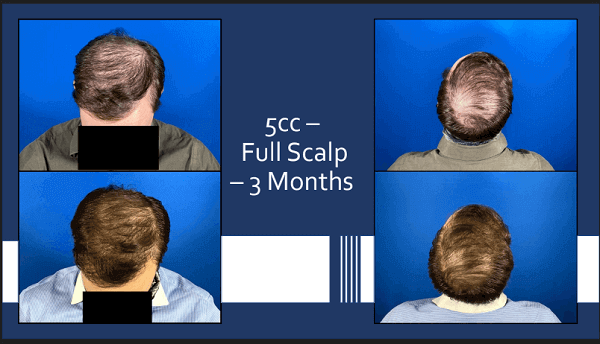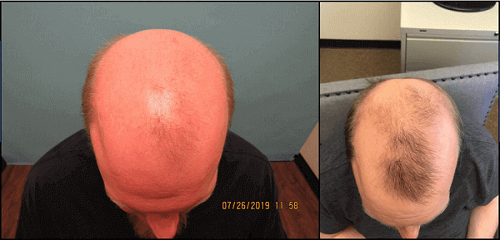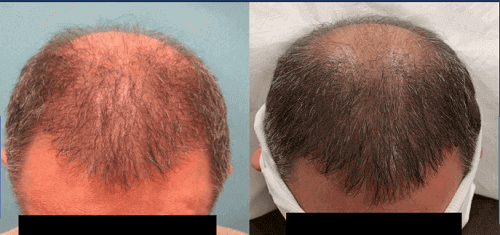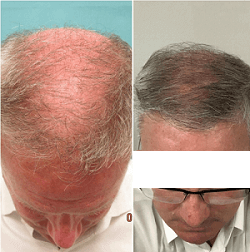List of Exosome suppliers to the hair growth market mentioned in this post:
1) Direct Biologics (US). Bone marrow derived.
2) Elevai (US). Wharton’s Jelly derived.
3) Kimera (US). Placental derived.
4) ExoCoBio (South Korea). Adipose stem cell derived from rose petals.
5) Exomide (South Korea). Adipose stem cell derived.
6) Vitti Labs (US). Placental derived.
7) New Life Medical Services (US). Dermal papilla cell derived.
8) Revive Exosomes (Thailand). Umbilical cord derived.
9) Dermoaroma (Italy). Derived from bovine colostrum (first milk).
When I wrote my first post on exosomes for hair growth in 2019 and an update in 2020, there were few companies that supplied the product in the US. And just one company was dominating sales to the hair loss market. However, it seems like doctors outside the US are nowadays using a much wider range of exosome products and suppliers. Hence the reason for this new post.
Note that the US FDA released a consumer alert in 2020 in relation to regenerative medicine products such as stem cells and exosomes. Thereafter, a number of hair transplant surgeons and dermatologists in the US stopped offering exosomes as a hair loss treatment. However, usage outside the US is far less regulated.
According to one well known US hair transplant surgeon who e-mailed me last year:
“The regulations is a real quagmire. Exosomes cannot be used with any claim of growing hair. You can’t market it. Some companies say that it is ok to use off-label as long as you don’t make claims. Others say you are at risk.”
“The debate over the use of placental or bone marrow still exists and I personally believe placental will be better.”
Bone Marrow versus Umbilical Cord
A number of key factors differentiate exosome products:
- Concentration in particles/mL. The typical range seems to be 0.5-2.5 billion p/ml, but much higher numbers are available and preferred (to some extent). For example, Direct Biologics says that every mL of its potent XoFlo product delivers over 10 billion extracellular vesicles (EVs). Vitti Labs EV-PURE product contains 15 billion extracellular vesicles per mL.
- Size in nm. The typical range is 30-200 nm.
- How the exosomes are derived. The two most common sources are bone marrow and perinatal (umbilical cord/Wharton’s jelly, placental and amniotic fluid).
In the case of bone marrow, the extracellular vesicles need to be derived from the marrow of a young adult who is in great health, has no diseases and hopefully led a healthy lifestyle. However, adult-derived stem cells will never be as good as what Dr. John Cole calls “T-0” stem cells (see video further below).
Also of note are differences in delivery mechanisms (often governed by national regulations). Injections, microneedling and even just plain topical application all seem to be popular.
Also relevant are the specific cells used to derive the exosomes from. A September 2023 literature review analyzed 16 studies on exosome treatment for hair restoration. The extracellular vesicles were isolated from either adipose-derived stem cells (ADSCs) or dermal papilla cells (DPCs). The results were deemed to be favorable. In fact, even topical ADSC exosomes demonstrated significant increases in hair density and thickness in 39 AGA patients. No significant adverse reactions and side effects were reported across the 16 studies.
List of Exosome Suppliers for Treating Hair Loss
The below list of companies have become well known for making exosomes specifically for the hair growth market.
Direct Biologics
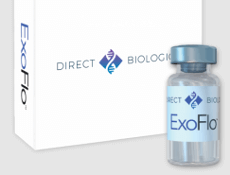
The most popular exosome producing company in the US (when it comes to the hair growth market) is Direct Biologics. When I wrote my post in 2019, all of the main hair transplant surgeons seemed to be using their ExoFlo™ product (also marketed as XoFlo™). Among these included Dr. Jerry Cooley, Dr. Daniel McGrath and Dr. John Cole. However, the Direct Biologics product is drived from bone marrow mesenchymal stromal/stem cells (BM-MSCs). So is not a “T-0” product.
Elevai
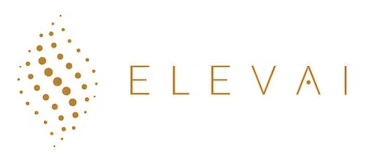
Based on two recent favorable reviews, I am curently most excited about Elevai (US). Just under half-way into the below recent October 2023 video, Dr. John Cole implies that he is currently a fan of Elevai exosomes and the company’s CEO. These extracellular vesicles are mesenchymal-derived stem cells from Wharton’s Jelly (i.e., the umbilical cord). So it is a “T-0” exosome.
Moreover, in a recent interaction on Instagram with Dr. Sahil Mrigpuri (India), he told me that he is seeing good results with exosomes sold by DermapenWorld (Australia). On the company’s website, they say the following:
“DermapenWorld has sourced ethically produced Exosomes. These are multipotent, highly versatile, the youngest and purest source. You can think of these as the cream of the crop.”
However, upon further research, I found out that Dermapenworld is in fact buying these from Elevai Labs. Note that Dermapenworld is the manufacturer of the world’s leading microneedling pen.
Kimera
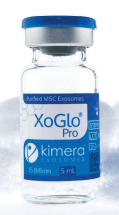
Also well known in the US is Kimera. According to an interesting article on their site, the company’s exosome products:
“Include sterile suspensions of isolated MSC exosomes derived from isolated, perinatal, mesenchymal stem cells.”
On one of the pdfs on the company’s website, they claim that their XoGlo® exosomes:
- Increase the number of hair follicles in the growth phase.
- Regenerate dermal papilla cells of the hair follicles.
The company’s placental-derived exosomes were found to be effective in a 2021 study analyzing their topical use for skin aging reversal. The company also makes a Vive topical skin serum exosome product that is derived from donated human placenta.
ExoCoBio
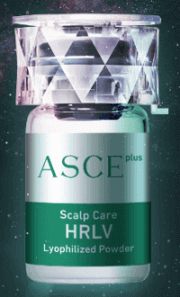
Another well known supplier is ExoCoBio (South Korea). The company’s product for hair loss is called ASCEplus HRLV (Advanced Skincare Complex from ExoCoBio Hair Rejuvenation Lyophilized Vial). It is derived from adipose mesenchymal stem cells.
In May 2023, ExoCoBio was granted an interesting patent related to rose stem cell-derived exosomes (RSCE™) using its proprietary ExoSCRT™ technology. Not sure why someone would prefer roses to humans. Perhaps it is a way to get around government regulations and clinical trials when it comes to cosmetic treatments.
Dr. Sophie Menkes (Switzerland) told me that she uses the rose stem-cell derived exosomes from ExoCoBio for hair rejuvenation with great results (since human-derived is not allowed in Europe). Per Dr. Menkes, she treats patients in five sessions (after microneedling at 0.5 mm), with each session being two weeks apart. Thereafter, you need one session every three months, or else the hair starts to fall out. Cosmetic use (but without injections) is allowed in Europe, including after a laser treatment.
In June 2023, ExoCoBio pubished a paper on its extracellular vesicles (extracted from adipose-derived stem cells) and wound healing. Below is a 2020 presentation from their CEO where he discusses the company’s product and its effect on hair growth.
Exomide
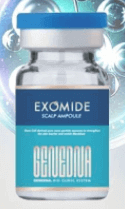
A doctor from Australia mentioned to me that he is using locally based Xytide company’s Exomide (originally developed in South Korea). On Xytide’s site, it is claimed that this product delivers stem cell-derived exosomes to target skin rejuvenation and hair growth. In Australia, you can only use exosomes topically, so this doctor is applying the product in tandem with microneedling.
Vitti Labs

Dr. Ron Shapiro told me about Vitti Labs (US) several years ago. They make EV-PURE placental-derived exosomes that are donated by volunteers undergoing C-section. On the company’s website research page, it shows that they have already completed Phase 2 trials for use of these products in Covid patients. They are scheduled to begin Phase 1 trials for a number of health conditions soon, though nothing in the hair loss or cosmetics sector.
New Life Medical Services
I have covered Florida (US) based Dr. Joe Greco many times on this blog. He is perhaps the most experienced provider of platelet-rich plasma (PRP) treatments for hair loss in the US. He is also betting big on exosomes. He sent me the below update:
”
My son (Joe Greco III, MD) and I are developing protocols, testing and working with the BioScientist at New Life Regenerative Medicine (US) on the “next generation” of exosomes for hair: Dermal Papilla Exosomes (DP EXOS).
Independent, in vivo studies and mouse models, demonstrate that Exosomes derived from DP cells promote hair growth and hair regeneration by regulating the activity of follicular dermal and epidermal cells.
We feel the advantages of DP EXOS in theory are:
1. Cell-to-cell communication: These exosomes carry specific signals that can directly communicate with other cells involved in hair follicle development and regeneration, enhancing their effectiveness.
2. Hair follicle-specific factors: Dermal papilla exosomes contain a variety of factors that are specifically required for hair follicle development and growth. These factors include various growth factors (such as VEGF, FGF-7, and IGF-1), extracellular matrix proteins, and microRNAs. These components can provide the necessary signals and stimulate the proliferation and differentiation of hair follicle stem cells, leading to hair regeneration.
3. Localization and proximity: Dermal papilla cells are located at the base of the hair follicle, in close proximity to the hair follicle stem cells. This proximity allows the exosomes released by dermal papilla cells to directly target and influence the adjacent stem cells, facilitating hair regeneration. Other exosomes from distant sources may not have the same direct access to the hair follicle stem cells, limiting their effectiveness.
4. Natural hair growth regulation: Dermal papilla cells naturally regulate hair growth cycles by transitioning hair follicles between growth (anagen), rest (telogen), and shedding (catagen) phases. The exosomes secreted by dermal papilla cells carry signals that can modulate this hair growth regulation system, promoting hair regeneration.
”
Revive Exosomes
Revive exosomes are made by a Thailand based company called Regenerative Medicine Ltd. that I just discovered via the below video. Their CEO Brian Dardzinski seems pretty accomplished in the regenerative medicine and stem cell space.
Revive extracellular vesicles are derived from umbilical cord mesenchymal stem cells and currently come in two varieties: Revive EXO-15 (15 billion exosomes) and Revive EXO-25 (25 billion exosomes). The below presentation is geared towards skin aging applications, but there is some discussion about other uses, pricing, US government regulations and more.
Dermoaroma
Dermoaroma (Italy) produces an especially unique exosome product called Purasomes HSC50+. The company’s products contain 20 functional growth factors and 20 billion exosomes. Moreover, these are derived from organic bovine colostrum. The cow breed they use are Holsteins from Italian family owned organic farms.
Colostrum (first milk) is the first form of milk that is produced by the mammary glands of humans and other mammals immediately following delivery of a newborn. The Purasomes product also contains curcuma longa stem cells and a unique peptide complex. It supposedly increases miRNA-31 expression by 500%.
Others
Other companies that I have heard about that offer or plan to offer exosomes for hair loss include Novus (US) and Avalon GloboCare (US). However, their sites currently show no specific pages on this particular usage.
More Effective than PRP
A number of hair transplant surgeons have in the past told me that the hair growth results from exosomes are far superior to platelet-rich plasma (PRP). Exosomes contain more plentiful growth factors and signaling molecules for hair regeneration. In particular, those that are derived from embryonic “T-0” stem cells (i.e., placental) have the most regenerative potential. One doctor who saw an increase in dermal papilla cells in some of his patients that were being treated with exosomes even calls them “nuclear PRP”.
